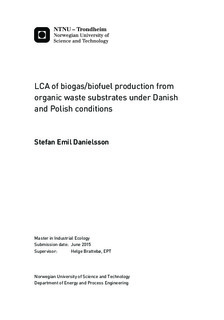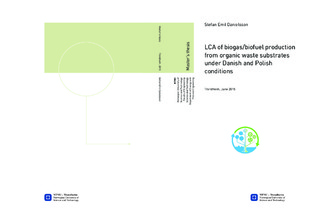| dc.contributor.advisor | Brattebø, Helge | |
| dc.contributor.author | Danielsson, Stefan Emil | |
| dc.date.accessioned | 2015-10-12T14:00:30Z | |
| dc.date.available | 2015-10-12T14:00:30Z | |
| dc.date.created | 2015-06-25 | |
| dc.date.issued | 2015 | |
| dc.identifier | ntnudaim:13968 | |
| dc.identifier.uri | http://hdl.handle.net/11250/2354141 | |
| dc.description.abstract | Anaerobic digestion (AD) of organic waste and manure in Denmark (DK) and Poland (PL) is in expansion and it is believed to contribute considerably to reaching the EU goals on reducing CO2 and establishing a sustainable energy system. This study analyzes the national potentials and per-forms lifecycle assessment (LCA) on an AD system compared to the current practice of incinerating waste and on-farm manure spreading. This mainly concerns the interconnection of energy and nutrient flows. Among 11 scenario variants for DK and for PL the highest climate impact saving was caused by PL (-1729 kg CO2 eq/t DM) from incineration (INC) with on-farm manure spreading compared to DK (-856 kg CO2 eq/t DM) mainly due to CHP replacement of more fossil rich energy. This is the general picture for PL having more CO2 intensive energy resources and thus the choice of energy marginal to replace can be decisive. The only variants yielding net GHG for both countries is from producing biofuel for diesel substitution but without nutrient recovery (compost), and from energy intensive LBG production despite of CO2 capture and substitution. The only scenario with opposite impacts for DK (-47 kg CO2 eq/t DM) and PL (119 kg CO2 eq/t DM) is found when 40% DM sludge undergoes AD and the VS/DM ratio for DK sludge is 50% higher than for PL. The difference is also caused by the use of energy type for biogas upgrading. Storability of biofuel is considered key for flexibility in a sustainable energy system, unlike CHP utilization. In all cases there is a trade-off between LBG and CBG benefits in terms of transportation. Utilization of bioresidual from nutrient rich organic substrates can significantly reduce emissions from producing mineral fertilizer. DK scenarios showed that dry matter content and volatile solids are decisive for maximized CH4 production and thereby fossil replacement. Optimal substrate mixtures of manure and waste for INC combined with replacement of CO2 intensive energy can yield high GHG sav-ings but is limited by the on-farm GHG emissions which are considerable. CHP for both AD and INC systems can be decisive for system performance and depend on the efficiency and energy marginal replaced. Also climate change and fossil depletion is very sensitive to fugitive CH4 emis-sions, while terrestrial acidification and marine ecotoxicity can be sensitive towards dry matter of biofertilizer and spreading practices. Excluding use of the liquid fraction of separated bioresidual lowers nutrient leaching potential but also the mineral fertilizer replacing potential. For instance this trade-off will rely on decision makers and the choice of weighting impact categories can contribute to choosing the environmentally most sound waste management options. | |
| dc.language | eng | |
| dc.publisher | NTNU | |
| dc.subject | Industriell Økologi, Environmental Systems Analysis | |
| dc.title | LCA of biogas/biofuel production from organic waste substrates under Danish and Polish conditions | |
| dc.type | Master thesis | |
| dc.source.pagenumber | 147 | |

